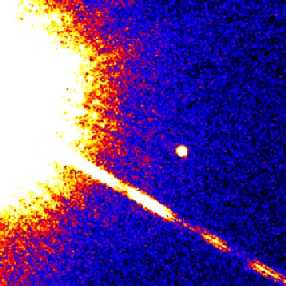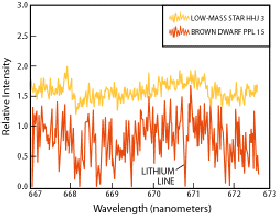Brown dwarfs
Brown dwarfs (BD) are objects between the giant planets and the smallest stars. In these objects thermonuclear reactions
occur, but their nucleus is not able to start a stable hydrogen fusion, like the red dwarfs![]() ; for this reason they are not considered real stars. These objects emit mainly infrared radiation
; for this reason they are not considered real stars. These objects emit mainly infrared radiation![]() , due to their low surface temperature.
, due to their low surface temperature.
Because
of their faintness, the first brown dwarf was not discovered untill 1995
by a Californian astronomical team: it was Gliese 229b (Fig. 1), the Gliese 229a companion; it has the typical parameters of a brown star, its radius is 70000 km (0,1 times the solar radius) and the temperature is less than 2600 oK.
 |
Fig. 1: An image of the couple of stars Gliese 229a and Gliese 229b obtained
using the 1.5 m Mount Palomar telescope; the bright star on the left is the red dwarf Gliese 229a, the fainter star in the center is the brown dwarf Gliese 229b. The brillant stream under the brown dwarf is an instrumental effect due to the light diffusion from the secondary mirror support of the telescope. (Credit: Photo Caltech; 29/11/1995) |
When a star has an initial mass of less than 0.075 solar mass![]() during the initial contraction its core is transformed into degenerated matter
during the initial contraction its core is transformed into degenerated matter![]() before the temperature reaches 8 million oK,
that needed to start hydrogen transformation, as occurs in the main sequence stars
before the temperature reaches 8 million oK,
that needed to start hydrogen transformation, as occurs in the main sequence stars![]() .
.
If the star mass is greater than 0.013 solar mass![]() , the nucleus temperature is higher than 500000 oK
and this allows for the deuterium
, the nucleus temperature is higher than 500000 oK
and this allows for the deuterium![]() (d)-proton (p) thermonuclear reaction
(d)-proton (p) thermonuclear reaction![]() : (d + p
: (d + p ![]() He3 + gamma radiation
He3 + gamma radiation![]() ); with a few million oK of temperature the light elements (lithium, berillium and boron) transform into He3 and He4
through the interactions with the hydrogen.
); with a few million oK of temperature the light elements (lithium, berillium and boron) transform into He3 and He4
through the interactions with the hydrogen.
Because there are low amounts of light elements
in the stars, the brown dwarfs have a maximum luminosity phase lasting only
a few million years, then they slowly become cold. When these objects are old they are difficult to see,
so for this reason it is more probable to see brown dwarfs in young open globular cluster![]() .
.
 |
Fig. 2: Comparison between the spectrum of a low mass normal star (yellow color) and the spectrum of PPL 15 brown dwarf (red color), where it is possible to see a lithium line. |
The brown dwarfs may be identified by their spectral features, for example from the lithium and methane lines. The lithium lines are present in the spectrum of the brown dwarfs with
a surface temperature of less then 1600 oK and a mass less than 0.06 solar mass, like the PPL 15 star (Fig. 1): its nucleus has a temperature
of less than 2 million oK, the temperature needed to obtain helium from lithium and hydrogen.
These objects are now one of the hottest topics in astronomy. In the galaxies![]() , brown dwarfs may be numerous as the main sequence stars and contribute to the universe's "barionic dark matter".
, brown dwarfs may be numerous as the main sequence stars and contribute to the universe's "barionic dark matter".
The Webweavers: Last modified Mon, 11 Oct 2004 10:01:47 GMT